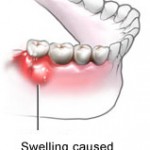 What is a tooth abscess?
What is a tooth abscess?
Abscess is a collection of pus in a cavity formed by the tissue due to bacterial infection or trauma by foreign objects. The pus is formed by dead inflammatory cells and bacteria. It is a defensive reaction of the tissue to prevent the spread of infection to the other parts of the body. A tooth abscess is pus enclosed in the tissues of the jaw bone at the apex of the root. There are three types of tooth abscess:
1. Periapical /periradicular abscess – the abscess starts at the apex of the root due to infection of the pulpal tissues
2. Periodontal abscess– Â starts in the periodontal pocket.
3. Gingival abscess- also known as gumboil, starts in the gum tissues, usually due to trauma by foreign objects
What causes tooth abscess?
1. Periradicular abscess
When a dental decay starts it attacks the tooth from the outermost hardest layer, the enamel, followed by a softer dentine. Severe untreated decay will undermine both layers and infect the pulp. In the initial stages the damage to the pulp is reversible and the pulpal cells will undergo inflammatory changes in response to the infectious process. Patient will feel extreme temporary pain which is reversible at this stage. As damage continues, pain will get less severe but persistent. However the pulp will eventually die as the infection is left untreated and this process is known as ‘pulp necrosis’. The infection will spread to the outer region of the root causing what is known as periradicular abscess.
Periradicular abscess can also occur secondary to failure of root canal treatment. Root canals which are not adequately cleaned and filled will harbor the growth of bacteria. These bacteria will then cause the formation of an abscess.
2. Periodontal abscess
Periodontal abscess involves the supporting tissues of the tooth. There are several predisposing factors for periodontal abscess formation:
-Obstruction of the opening to a deep pocket
-Injury to the gums with a foregn body eg. splint, toothbrush bristles. The foreign body will carry bacteria into the damaged tissues, hence causing infection to start. Also careless manipulation of gingival tissues during dental treatment may also carry microorganisms into the damaged tissue.
– Periodontal abscess occurs more likely in patients with altered host response, as in patients with diabetes. The high sugar level in blood serves as nutrient to the bacteria, enabling it to thrive and initiate an infection. Increased blood glucose also impairs the actions of host defense cells against the bacteria. Patients with diabetes usually have multiple periodontal abscess which manifest as fluctuant swelling on the gums from which pus discharges. Diabetes has sometimes been diagnosed following the appearance of multiple periodontal abscess.
– Excessive force on the tooth will damage the periodontal tissues. This happens in cases of tooth grinding (unconscious habit, due to stress) , blow to the tooth and excessive orthodontic pressure. The damaged tissues become easily infected when subjected to poor oral hygiene and this leads to formation of pus.
– The gum pockets have the tendency to shrink after scaling and plaque removal. If the calculus and debris are not completely removed, the gingival tissue shrinks, leaving the bacteria in the pocket. Unexposed bacteria will proliferate and damage the gum surrounding gum tissues.
– Infection from a grossly decayed tooth can spread from the periradicular area to the periodontal tissues. Sometimes, the tooth will have accessory canals which are infected and undetectable due to its small size. Infection from these canals will spread to the periodontal tissues.
– Careless instrumentation during root canal treatment may injure the periodontal tissues causing damage and secondary infection.
3. Gingival abscess
Gingival abscess only involves the gums, sparing the periodontal tissues. The abscess formation is mainly due to trauma with foreign object, introducing infection into the damaged tissues.
Signs and symptoms
Patient with periradicular abscess will experience sudden pain on biting and deep throbbing pain. The involved tooth may feel high and loose. The tooth involved is non vital because the pulp is dead due to infection.If infection is left untreated, it may spread into the deeper tissues of the face causing facial swelling and pain. There may be enlargement of the associated lymph nodes and body temperature rise.
In periodontal abscess, the tooth may be vital if the infection is primarily in the supporting tissues alone. The overlying gingiva becomes red and swollen. It is also tender. Initially the swelling is not fluctuant but as the infection becomes worse, there will be pus discharge.
Management
Periapical abscess: The associated non vital tooth has to undergo root canal treatment. The pus is drained, the root canal if cleaned and filled with a suitable material. If the tooth has poor prognosis then it may need extraction.
Periodontal abscess: The pus is drained followed by scaling. Patient has to be recalled to monitor the periodontal status.
Antibiotics are prescribed only when there is sign of spread of infection such as facial swelling,temperature rise or regional lymph node enlargement.